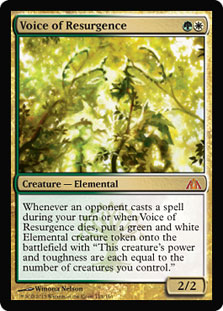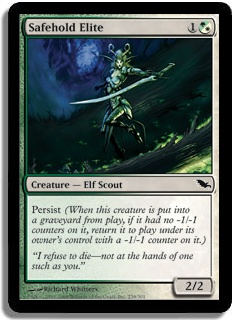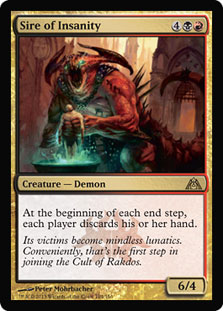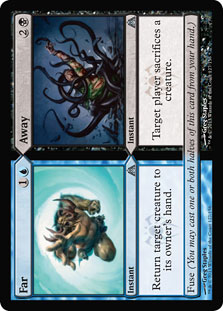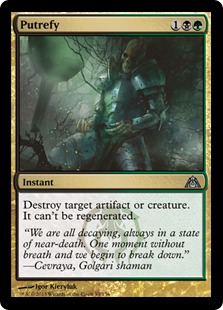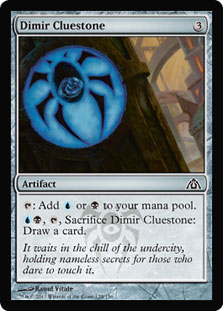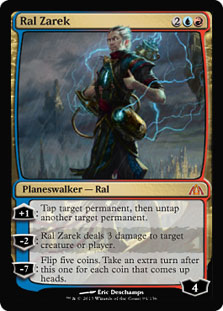“Thragtusk is just a good value card. It’s not insane or anything.”
“Thragtusk is the best card. What’s the next Thragtusk?”
“Thragtusk isn’t even good anymore.”
People sure are quick to go to extremes, overcompensating for new information. Information bias is a distortion of reasoning when evaluating new information. This is most commonly experienced when one learns something new and then tries to apply it to things where it is irrelevant or mostly irrelevant. This also manifests itself when people want as much information as possible before making a decision—even to the point of seeking out irrelevant information as though it would improve their ability to make decisions (in fact, the opposite is true at some point).
Dragon’s Maze is less than three weeks out, and preview season is always ripe with information bias. Every card might be the next best card ever or is just bad. It doesn’t help that in the Internet magazine game extremes get quoted, get retweets, get hits, and get remembered.
“Tried to tell everybody alive, buy Jace while he’s still twenty-five.”
Of course, most cards are going to be somewhere in the middle of the bell-shaped curve, and most top cards are going to be merely tier 1, not ban-worthy. Still, seeking out the best of the best is a game in and of itself. What is going to be the next Thragtusk?
A regular pattern people fall into when evaluating Magic cards is thinking that cards that are like something they understand are good while cards that are unlike anything they are understand are bad. Love him or hate him, Thragtusk has proven so strong that everyone wants to find the next Thragtusk. While they should be looking for the next card of that power level, the easier thing to do is look for cards that bear a resemblance.
This is part of why everyone is talking about Voice of Resurgence.
From the moment it was previewed, Voice of Resurgence has been a hot topic. One contributing factor is that it is a creature that gives you another creature when it dies and is obviously at least a competitive rate (since you are clearly not being charged much for those abilities). How good is it really? Preselling for $20 already? When was the last time a mythic two-drop actually went for $20?
Hold on, now, those aren’t mythics! Those are all rares.
1. Counting Tarmogoyf and Dark Confidant as non-mythics is cheating
2. Lotus Cobra
Anyway, the point is that its size matched up with its rarity will throw a few people, but that shouldn’t stop up from looking at the card objectively. Admittedly, Voice of Resurgence’s template leaves a bit to be desired. Half of the people I know read this text box and assumed you would be left with a 1/1 after a Supreme Verdict (since the number of creatures you’ll control is one). However, the token’s stats continually adjust based on your current creature count, so it will only be a 1/1 until you play anything.
Ok, let’s figure out what we’re working with here. I mean, this is just a 2/2 that if it dies gives you another creature, right? Well, yeah, but that is kind of a lot. Like a whole lot.
So, not too long ago, there was this little fellow:
Safehold Elite is pretty clearly significantly below Voice of Resurgence. Admittedly, Safehold Elite’s casting cost is easier, but setting that aside Voice is just much stronger. How much is the upgrade worth, however?
Well, combos aside (such as +1/+1 counters), we are basically comparing a 1/1 to a Scion of the Wild. Of course, it’s not like we’d really pay 1GG for a Scion of the Wild these days. Wayfaring Temple is basically the same cost for the same text but with the populate upside. While 1GG is a little pricey for this text, three colorless is pretty close to baseline and GW would be a steal. As for the 1/1? Well, we might pay as much as zero for a 1/1 assuming it actually cost us a card.
So it looks like we’re getting almost three colorless mana more in value after it dies compared to Safehold Elite. How much is that worth up front? Death triggers are highly variable in value to a deck, as their power fluctuates tremendously depending on how easy it is for your own creatures to die in your strategy and how many opponents are reliant on killing creatures to further their game plan.
A good rule of thumb, however, is to count death triggers as being worth half of retail. For instance, drawing a card might be worth almost two mana to us, but not getting it until the creature dies makes the ability worth about one. If the token we’re getting from Voice of Resurgence is worth about three colorless when you finally get it, it’s probably worth about one and a half colorless mana up front.
Generally, the baseline for small creatures is a 2/1 for W (or G), though we can frequently do better. Getting a 2/2 for W is slightly above rate (Isamaru was certainly a lot more popular than Elite Vanguard despite having the legendary drawback). One way to look at Voice of Resurgence is that we are basically paying W for a 2/2 (not a legend) and G for the ability to get a Scion of the Wild when it dies. Already, that’s a pretty good deal and slightly stronger than Isamaru on raw power.
However, this doesn’t factor in two other important elements. First, Voice of Resurgence actually has another ability. While it creates a Scion of the Wild Elemental when it dies, that’s just the beginning. It also triggers whenever an opponent casts a spell during your turn!
This has a ton of implications. To begin with, this is a very strong anti-counterspell card. People have long played cards like Eyes of the Wizened. They haven’t always been good, but there is a big difference between paying a card and two mana versus paying next to nothing. Voice of Resurgence does cost a card and two mana, but you are also getting other effects worth at least that much already.
This one doesn’t just stop counterspells, though. Tired of Restoration Angel making attack phases a nightmare? Voice of Resurgence neuters flash creatures to a large degree. You still have to be careful when deciding whether to swing with the Voice, itself, however. Many opponents would gladly flash down an Angel and give you two Elementals in exchange for getting it off the table.
Snapcaster Mage would normally be very annoying for a 2/2 creature like Voice, but the anti-flash ability means that Snapcaster Mage could potentially double trigger it (with a third Elemental possible if the Voice dies). Most of the time, this is far too great a cost to pay so the Snapcaster Mage will just get played main phase; however, this does reveal just how good of a Teferi impression Voice can do.
Unsummon is generally a pretty effective defensive tool at making sure that combat doesn’t go too wrong or that a removal spell can be countered. Voice obviously interferes with this, but it also puts pressure on players to make decisions at awkward times. For instance, if an opponent has seven mana, a Sphinx’s Revelation, an Unsummon and a Negate, what’s their play? They want to protect themselves from Garruk, Primal Hunter or a removal spell on their Angel, but they also want to Sphinx without giving you an Elemental. Maybe it’s worth giving you an Elemental to keep Garruk off the table, but if they have to Sphinx main phase, they won’t even have that option.
Overall, I gotta put myself squarely in the camp of “this card is awesome.” It is not Restoration Angel, but I bet when all is said and done this is easily in the Top 5 new cards of Dragon’s Maze. It’s a totally reasonable card in its own right, but it hoses some very powerful cards and strategies. While it is awesome against removal, it’s also quite good against people with no removal (as the Scion of the Wild gets pretty sick if all your creatures are allowed to live!).
There is some counter play, and the mere existence of Voice of Resurgence will cause ripples in card choice across the entire format. This means the card is likely to be bananas on week 1 before people understand what it does to the format. However, there are other eventualities that can be predicted. For instance, Voice of Resurgence existing hurts Zombies.
Why?
One interesting consequence of Voice of Resurgence is the increase in value of Pillar of Flame. While Thragtusk’s “leaves play” trigger gets around Pillar of Flame, “dies” requires going to the graveyard by definition. This means if you want it, Pillar of Flame is an answer to Voice of Resurgence that can actually get out from under it without losing value. While Pillar is the most efficient, Annihilating Fire, Turn // Burn, Oblivion Ring, Detention Sphere, and Rest in Peace all sidestep his death trigger as well. Generally, cards that stop Voice of Resurgence also stop Geralf’s Messenger and Gravecrawler.
Of course, Voice of Resurgence can be countered, and if it is there is no inherent loss of value. However, as a creature it can also be played via Cavern of Souls. An uncounterable anti-counterspell card is a pretty gigantic beating as far as hate cards go. Amusingly, Voice has some potent synergy with another anti-counterspell hate creature previewed recently.
Sire of Insanity is a pretty ruthless Craw Wurm as far as Craw Wurms go!
The obvious comparison is to Rakdos’s Return, though there are a number of important differences between them. To begin with, instead of doing a bunch of damage to your opponent’s face, Sire of Insanity makes you Mind Twist yourself.
Err, that doesn’t sound so good.
Of course, that is only part of the package deal. Those are the costs, but there are a lot of really big upsides.
To begin with, Sire of Insanity leaves you with a 6/4 body. That is not trivial. After Mind Twisting someone, a big body is one of the best things you could be left with.
Rakdos’s Return doesn’t always hit their entire hand. No question it does a fair bit, but if you Rakdos’s Return someone for four and they respond with a Sphinx’s Revelation for three or four, they usually have the better of it. Not so with Sire of Insanity. If you drop this guy against someone with Sphinx’s Revelation, they don’t really get very far.
Of course, Rakdos’s Return is also something someone can recover from. A Think Twice into a Sphinx’s Revelation and we’re back in business. Sire of Insanity actually Mind Twists everyone every turn! They don’t even get a chance to play cards on their own turn. It’s literally a wrap, everyone drop everything.
Finally, a very important distinction between Sire of Insanity and Rakdos’s Return: Cavern of Souls! It’s already not trivial that Negate doesn’t counter Sire of Insanity, but with a Cavern on Demon we are talking about uncounterable Mind Twists!
This is not to say there is no counter play to Sire of Insanity. Far from it! The most immediate way to punish Sire of Insanity is Unsummon. Unsummon gives you two reasonable options against him—either bouncing him before the end step (buying yourself one more turn of having a hand) or bouncing him in the end step with the trigger on the stack (you lose your hand, but so does your opponent…and Sire of Insanity along with it).
While Unsummon has gained quite a following in the wake of Vapor Snag, Far // Away is a Dragon’s Maze Unsummon variant that is probably going to see a fair bit of play in the year to come.
These are two great options that combine very synergistically (letting you Edict the better of their two creatures if you want) while also having a lot of synergy with comes into play abilities like Augur of Bolas and Snapcaster Mage. A correction from Monday, like overload, you can’t fuse a split card while Snapcastering it back. It still works great with Snapcaster Mage when cast, but if you want to actually loop it, you need something like Archaeomancer. That said, if you do combine it with Archaeomancer, you can actually soft lock out creature decks entirely. Every time they play a guy, bounce your Archaeomancer and Edict them. Then on your turn replay the Archaeomancer.
Another correction on fuse, it looks like the gold fuse cycle are not allied Shards but actually span across all ten guilds evenly (albeit distributed unevenly, as some guilds share a card with an ally, others with an enemy).
Far // Away is not so insane that it pushes every other option away—far from it. Devour Flesh, Tribute to Hunger, Liliana of the Veil, Barter in Blood—we are talking a lot of somewhat close options, and those are just Edict effects. It is just worth noting that this is another tool blue decks can use to fight Sire of Insanity. Ahead on board? Bounce him and let’s do this! Is Sire of Insanity their only guy? Edict and move on.
At the end of the day, however, Sire of Insanity is still just this guy, and guys can get Murdered. Interestingly, this is a pretty big reason to play some instant speed kill (seeing as Mizzium Mortars and Dreadbore don’t kill him in time). Turn // Burn may be the most controversial of the new hard kill spells, but there’s another that has got to get the award for least controversial:
Putrefy was an instant hit last time, and everyone knew it immediately. Artifacts are not at their most popular, but there is little doubt that success will continue. The biggest difference this time around is that Putrefy is up against a ton of other respectable options and almost necessarily will see less play as a result. That said, it will probably see more play than most of its peers. They are all so close that there is a lot of reason to diversify.
I don’t know about you guys, but I love how much gold is in Dragon’s Maze. Alara Reborn was too much, making it not mean anything anymore. However, the artifacts, lands, split cards, and monochrome cards help break it up nicely despite how guild-heavy the set is.
I have noticed a lot of people seem to be under the impression that the shocklands are not in the set and only appear the Prerelease packs. This is erroneous, and Dragon’s Maze having a nonbasic land slot instead of a basic land is actually true for every single pack!
While there will be more shocklands flowing into the competitive scene, the density in Dragon’s Maze is a lower than Return to Ravnica and Gatecrash. Almost one in ten packs of those two sets contained a shockland, while in Dragon’s Maze there will be one in twenty.
In addition to Guildgates and shocklands, Dragon’s Maze also features a cycle of common artifact mana sources, the Cluestones:
It’s slightly odd just how close they are to the Keyrunes, but I guess there aren’t a ton of costs you can make artifact mana if you don’t want them to cost three.
One of the tough challenges for the Keyrunes was how many of them offered bodies that people didn’t really want. A 2/2 flier isn’t exactly what a control deck is looking for, for instance. Rakdos Keyrune has been a hit, but that’s largely because a 3/1 first strike creature is actually well positioned.
The major advantage of Cluestones is that they offer something that all decks slow enough to use a three-cost artifact mana source actually want: more cards.
Using too many Keyrunes was risky because of cards like Detention Sphere and Ancient Grudge. Cluestones sidestep this nicely by giving you the opportunity to cycle them. I still wouldn’t want too many because it would be easy to get glutted with three-cost artifact mana, but a couple of these here and there might make for some nice improvements to slower decks.
It’s going to be particularly interesting to see what these do to Block. That is a lot of mana fixing, which is great to see, but it’ll be fun to see what happens when that goes face to face with the fast aggro strategies that have been popular in the format thus far. One thing that’s certain is that Sphinx’s Revelation will be at the center of level 1 of the format, either playing it or beating it.
I’m out for this week, but join me here Monday, which will be dedicated to this little guy right here…
Patrick Chapin
“The Innovator”

